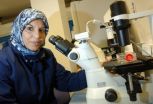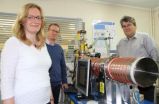(Press-News.org) Scientists at the University of Warwick have discovered that 'good' cholesterol is turned 'bad' by a sugar-derived substance.
The substance, methylglyoxal - MG, was found to damage 'good' HDL cholesterol, which removes excess levels of bad cholesterol from the body.
Low levels of HDL, High Density Lipoprotein, are closely linked to heart disease, with increased levels of MG being common in the elderly and those with diabetes or kidney problems.
Supported by funding from the British Heart Foundation (BHF) and published in Nutrition and Diabetes, the researchers discovered that MG destabilises HDL and causes it to lose the properties which protect against heart disease.
HDL damaged by MG is rapidly cleared from the blood, reducing its HDL content, or remains in plasma having lost its beneficial function.
Lead researcher Dr Naila Rabbani, of the Warwick Medical School, says that: "MG damage to HDL is a new and likely important cause of low and dysfunctional HDL, and could count for up to a 10% risk of heart disease".
There are currently no drugs that can reverse low levels of HDL, but the Warwick researchers argue that by discovering how MG damages HDL has provided new potential strategies for reducing MG levels.
Commenting on the research's implications Dr Rabbani said:
"By understanding how MG damages HDL we can now focus on developing drugs that reduce the concentration of MG in the blood, but it not only be drugs that can help.
"We could now develop new food supplements that decrease MG by increasing the amount of a protein called glyoxalase 1, or Glo 1, which converts MG to harmless substances.
"This means that in future we have both new drugs and new foods that can help prevent and correct low HDL, all through the control of MG."
A potentially damaging substance, MG is formed from glucose in the body. It is 40,000 times more reactive than glucose it damages arginine residue (amino acid) in HDL at functionally important site causing the particle to become unstable.
Glo1 converts MG to harmless substances and protects us. MG levels are normally kept low in the body to maintain good health but they slowly increase with ageing as Glo1 slowly becomes worn out and is only slowly replaced.
Dr Rabbani says: "We call abnormally high levels of MG 'dicarbonyl stress'. This occurs in some diseases – particularly diabetes, kidney dialysis, heart disease and obesity. We need sufficient Glo1 to keep MG low and keep us in good health."
INFORMATION:
Notes to Editors:
To speak with Dr Rabbani please contact Tom Frew, International Press Officer – University of Warwick; a.t.frew@warwick.ac.uk +44 (0)2476575910
The British Heart Foundation (BHF)
For over 50 years we've pioneered research that's transformed the lives of people living with heart and circulatory conditions. Our work has been central to the discoveries of vital treatments that are changing the fight against heart disease. But so many people still need our help. From babies born with life-threatening heart problems to the many Mums, Dads and Grandparents who survive a heart attack and endure the daily battles of heart failure. Join our fight for every heartbeat in the UK. Every pound raised, minute of your time and donation to our shops will help make a difference to people's lives.
For more information visit bhf.org.uk.
For more information please call the BHF press office on 020 7554 0164 or 07764 290 381 (out of hours) or email newsdesk@bhf.org.uk.
Sugar substance 'kills' good HDL cholesterol, new research finds
2014-09-01
ELSE PRESS RELEASES FROM THIS DATE:
New tuberculosis blood test in children is reliable and highly specific
2014-09-01
A new blood test provides a fast and accurate tool to diagnose tuberculosis in children, a new proof-of-concept study shows. The newly developed test (TAM-TB assay) is the first reliable immunodiagnostic assay to detect active tuberculosis in children. The test features excellent specificity, a similar sensitivity as culture tests in combination with speed of a blood test. The promising findings are a major advance for the diagnosis of tuberculosis in children, particularly in tuberculosis-endemic regions.
The study has been published on Sept 1st, 2014 in Lancet Infectious ...
Scientists develop 'electronic nose' for rapid detection of C. diff infection
2014-09-01
A fast-sensitive "electronic-nose" for sniffing the highly infectious bacteria C. diff, that causes diarrhoea, temperature and stomach cramps, has been developed by a team at the University of Leicester.
Using a mass spectrometer, the research team has demonstrated that it is possible to identify the unique 'smell' of C. diff which would lead to rapid diagnosis of the condition.
What is more, the Leicester team say it could be possible to identify different strains of the disease simply from their smell – a chemical fingerprint - helping medics to target the particular ...
Why plants in the office make us more productive
2014-09-01
'Green' offices with plants make staff happier and more productive than 'lean' designs stripped of greenery, new research shows.
In the first field study of its kind, published today, researchers found enriching a 'lean' office with plants could increase productivity by 15%.
The team examined the impact of 'lean' and 'green' offices on staff's perceptions of air quality, concentration, and workplace satisfaction, and monitored productivity levels over subsequent months in two large commercial offices in the UK and The Netherlands.
Lead researcher Marlon Nieuwenhuis, ...
Doctor revalidation needs to address 7 key issues for success, claims report
2014-09-01
New research launched today, 1st September 2014, has concluded that there are seven key issues that need to be addressed to ensure the future success of doctor revalidation, the most profound revision in medical regulation since the Medical Act of 1858.
The research has been funded by the Health Foundation, an independent health care charity, as part of a long-term programme looking at different aspects of revalidation. The work has been carried out by academics at the Collaboration for the Advancement of Medical Education, Research and Assessment (CAMERA) at Plymouth ...
Memory in silent neurons
2014-08-31
When we learn, we associate a sensory experience either with other stimuli or with a certain type of behaviour. The neurons in the cerebral cortex that transmit the information modify the synaptic connections that they have with the other neurons. According to a generally-accepted model of synaptic plasticity, a neuron that communicates with others of the same kind emits an electrical impulse as well as activating its synapses transiently. This electrical pulse, combined with the signal received from other neurons, acts to stimulate the synapses. How is it that some neurons ...
A new synthetic amino acid for an emerging class of drugs
2014-08-31
One of the greatest challenges in modern medicine is developing drugs that are highly effective against a target, but with minimal toxicity and side-effects to the patient. Such properties are directly related to the 3D structure of the drug molecule. Ideally, the drug should have a shape that is perfectly complementary to a disease-causing target, so that it binds it with high specificity. Publishing in Nature Chemistry, EPFL scientists have developed a synthetic amino acid that can impact the 3D structure of bioactive peptides and enhance their potency.
Peptides and ...
Discovery reveals how bacteria distinguish harmful vs. helpful viruses
2014-08-31
When they are not busy attacking us, germs go after each other. But when viruses invade bacteria, it doesn't always spell disaster for the infected microbes: Sometimes viruses actually carry helpful genes that a bacterium can harness to, say, expand its diet or better attack its own hosts.
Scientists have assumed the bacterial version of an immune system would robotically destroy anything it recognized as invading viral genes. However, new experiments at Rockefeller University have now revealed that one variety of the bacterial immune system known as the CRISPR-Cas system ...
Why sibling stars look alike: Early, fast mixing in star-birth clouds
2014-08-31
VIDEO:
This 11-second movie shows a computational simulation of a collision of two converging streams of interstellar gas, leading to collapse and formation of a star cluster at the center. Face-on...
Click here for more information.
Stars are made mostly of hydrogen and helium, but they also contain trace amounts of other elements, such as carbon, oxygen, iron, and even more exotic substances. By carefully measuring the wavelengths (colors) of light coming from a star, astronomers ...
Mixing in star-forming clouds explains why sibling stars look alike
2014-08-31
VIDEO:
This computer simulation shows the collision of two streams of interstellar gas, leading to gravitational collapse of the gas and the formation of a star cluster at the center. The...
Click here for more information.
The chemical uniformity of stars in the same cluster is the result of turbulent mixing in the clouds of gas where star formation occurs, according to a study by astrophysicists at the University of California, Santa Cruz. Their results, published August 31 in ...
Antarctic sea-level rising faster than global rate
2014-08-31
A new study of satellite data from the last 19 years reveals that fresh water from melting glaciers has caused the sea-level around the coast of Antarctica to rise by 2cm more than the global average of 6cm.
Researchers at the University of Southampton detected the rapid rise in sea-level by studying satellite scans of a region that spans more than a million square kilometres.
The melting of the Antarctic ice sheet and the thinning of floating ice shelves has contributed an excess of around 350 gigatonnes of freshwater to the surrounding ocean. This has led to a reduction ...







